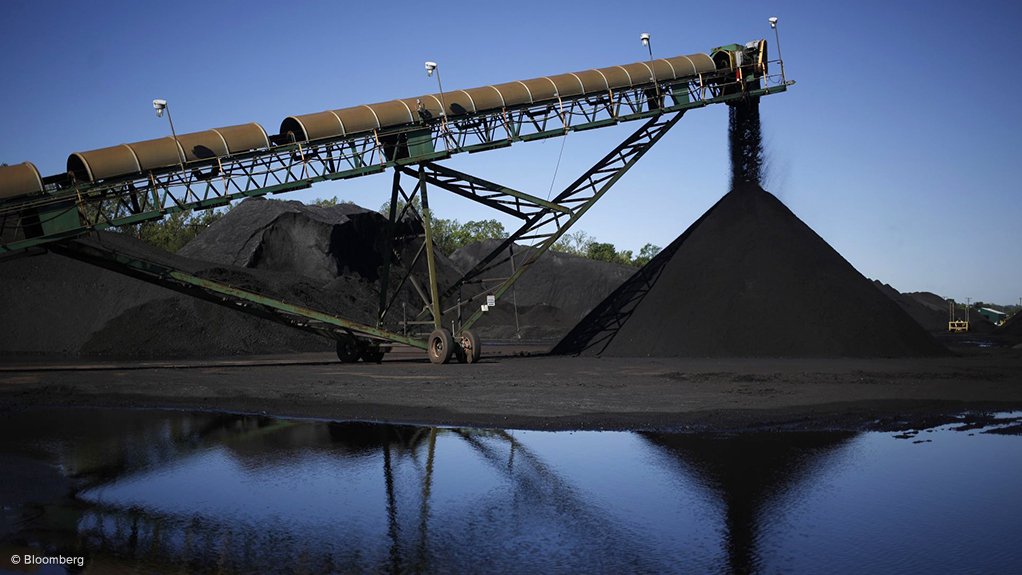Global coal demand, supply set to remain at an all-time high in 2023
Global body the International Energy Agency (IEA) expects coal demand to remain at an all-time high this year.
This follows after global coal demand reached an all-time high in 2022, rising above 8.3-billion tonnes, the IEA points out in its ‘Coal Market Update’ report for July 2023.
“We expect coal demand grew by about 1.5% in the first half of this year to a total of about 4.67-billion tonnes, backed by both an increase of 1% in power generation and 2% in non-power.
“We observed continued increases in China, India and Indonesia, which more than offset declines in the US, the European Union (EU) and Japan,” the IEA says.
It points out that the entity expects global coal-fired power generation to decrease in the second half of this year.
“For the whole year, we expect demand from the power sector to be 0.4% lower at about 5.6-billion tonnes. In the non-power sector, we expect growth to continue, reaching 2.79-billion tonnes for the full year.”
As a result of this growth, overall global coal demand is expected to remain flat at about 8.39-billion tonnes (+0.4%) this year.
Whether coal demand grows or declines this year will depend on weather conditions and on the economies of large coal-consuming nations, the IEA adds.
It points out that markets have returned to more recognisable patterns this year following the Covid-19-induced shock in 2020, the strong post-pandemic recovery in 2021 and the first truly global energy crisis as a result of Russia’s invasion of Ukraine in 2022.
These patterns included declines in coal demand in the US and the EU and continued growth in Asia.
The US and EU declines are driven by the power sector, with a combination of weak electricity demand and renewable energy expansion. For the US, cheap gas is also weighing on coal demand.
“We estimate that China’s coal demand increased by about 5.5% in the first half of this year. This is driven by a comparison effect with the first half of last year when Covid-related lockdowns weighed on the economy, and very low hydro output in the first quarter of this year, which pushed up reliance on coal-fired power generation.
“In the second half of this year, growth is expected to slow slightly, mainly owing to recovering hydropower availability after last year’s drought. We expect China’s coal demand this year to grow by about 3.5% to 4.68-billion tonnes, with demand from the power sector up 4.5% and demand from non-power uses growing by 2%.”
Owing to strong economic growth and coal reliance, India’s coal demand grew by about 5.5% in the first half of this year. With growth in the power sector slowing down a bit in the second half, the IEA expects a total increase of 5% for the year, totalling 1.21-billion tonnes.
Indonesia is set to remain the fifth-largest coal consumer this year, as economic perspectives are positive, and the power sector, the smelting sector and other industries are all expected to demand more coal.
The IEA, however, adds that, in the US, coal demand is continuing to decline, driven by the power sector.
After contracting by about 24% in the first half of this year, a slower decrease in coal demand is expected in the second half.
“Total coal demand this year is expected to drop to 357-million tonnes. Coal demand is also again on a downward trajectory in the EU and Japan, as well as Korea. In the first half of 2023, coal demand dropped by about 16% in the EU, and for the full year it is expected to decline by about 17% to about 372-million tonnes.
“The decrease is driven by weaker economic prospects, lower gas prices, nuclear recovery and ample power production by renewable resources. In Japan and Korea, these effects are limited, resulting in an expected demand of 179-million tonnes (-1.9%) in Japan and 117-million tonnes (-2.8%) in Korea.”
COAL SUPPLY
The IEA also expects global coal production to grow further this year, after global supplies expanded by 8% last year to a record 8.63-billion tonnes.
This further growth is driven by an expected strong ramp-up of production in China, India and Indonesia in the first six months, offsetting declines in the US and the EU. Russian coal production is estimated to have recovered in the first half of this year.
“In March this year, China reached another monthly record of 417-million tonnes, surpassing the previous record set in December last year. We expect China’s production to increase by 3.3% to 4.63-billion tonnes for the full year 2023.
“In the first half of this year, India’s supply rose by about 10%, reaching a new single-month production record of 107-million tonnes in March, according to India’s Coal Ministry, surpassing 100-million tonnes in a single month for the first time. For the entire year, we expect an increase in coal production to about 989-million tonnes (+7%), close to the Indian government's one-billion-tonne target.”
The IEA adds that Indonesia’s coal production grew by an estimated 16% to 353-million tonnes in the first six months of this year. Growth is expected to slow down in the second half, and an increase of about 8%, to about 695-million tonnes for the full year, is expected.
Owing to ongoing demand destruction owing to wide unavailability of coal power plants after years of poor maintenance and severe infrastructure issues, South Africa’s coal production is expected to decline by about 4.2% to 220-million tonnes this year. In the first half, production is estimated to have decreased by an even faster 10%.
“In the US, coal production turns downward again. Although production is expected to have increased by about 0.8% in the first half of the year, for the full year we forecast a 4.2% drop to 519-million tonnes, compared to a 22% decline in demand. Higher exports and stock building at power plants explain the gap.
“In the first six months of this year, coal production in the US plummeted by an estimated 17%, driven by falling demand from the power sector. In total, we forecast EU production to fall by about 8% to 321-million tonnes.”
The IEA adds that coal production is expected to slightly decrease by 2.9% to 429-million tonnes in 2023, after an estimated 1.4% increase in the first six months. Any forecasts for Russia are difficult under the current wartime circumstances, the IEA stresses.
Australia’s coal production is set to increase by 2%, as weather conditions enable producers to significantly expand production after they had been severely hit by La Niña weather conditions last year. The IEA anticipates coal production to rise to 460-million tonnes.
COAL TRADE IN 2023
Despite no new large-scale projects coming online, the IEA adds that high prices last year have left coal miners with stronger balance sheets, providing them with an opportunity to invest in sustaining as well as some expansionary capital expenditure (capex).
This, together with the end of La Niña weather conditions, which hampered production in Australia, has strengthened the coal supply outlook for this year despite coal prices retreating from their highs.
“Stronger coal supply and lower gas prices sent coal prices steeply downward towards the end of last year. The drops attracted price-sensitive buyers such as China and India, although the price declines were partially offset by the depreciation of the Chinese renminbi and the Indian rupee against the dollar.
“China and India ramped up imports at the beginning of this year, with China even ending its unofficial ban on coal from Australia. Until April, imports from China and India amounted to about 50% of global coal imports, as the two largest coal producers and consumers are also the largest importers.”
The IEA notes that, during the first half of this year, the EU temporarily turned into an exporter of thermal coal owing to ample inventories accumulated during the previous year and reduced coal-fired power generation.
In April this year, EU countries exported close to one-million tonnes. Export destinations included, among others, Morocco, India and China.
The IEA, however, stresses that elevated global demand for thermal coal imports is projected to be predominantly covered by Indonesian exports, expected to rise by 12% to about 525-million tonnes for the full year.
“Similarly, the elevated demand for metallurgical coal is anticipated to be mainly covered by additional exports from Mongolia, more than doubling to well over 40-million tonnes.
“Total exports of thermal coal are expected to increase to 1.1-billion tonnes (+5.2%), while metallurgical coal exports are forecast to reach 340-million tonnes (+11%) this year, with total coal trade expected to approach the record volumes seen in 2019. For seaborne coal trade, we project around 1.34-billion tonnes (about 93% of total coal trade) which would surpass the 1.33-billion tonnes record reached in 2019,” adds the IEA.
Comments
Press Office
Announcements
What's On
Subscribe to improve your user experience...
Option 1 (equivalent of R125 a month):
Receive a weekly copy of Creamer Media's Engineering News & Mining Weekly magazine
(print copy for those in South Africa and e-magazine for those outside of South Africa)
Receive daily email newsletters
Access to full search results
Access archive of magazine back copies
Access to Projects in Progress
Access to ONE Research Report of your choice in PDF format
Option 2 (equivalent of R375 a month):
All benefits from Option 1
PLUS
Access to Creamer Media's Research Channel Africa for ALL Research Reports, in PDF format, on various industrial and mining sectors
including Electricity; Water; Energy Transition; Hydrogen; Roads, Rail and Ports; Coal; Gold; Platinum; Battery Metals; etc.
Already a subscriber?
Forgotten your password?
Receive weekly copy of Creamer Media's Engineering News & Mining Weekly magazine (print copy for those in South Africa and e-magazine for those outside of South Africa)
➕
Recieve daily email newsletters
➕
Access to full search results
➕
Access archive of magazine back copies
➕
Access to Projects in Progress
➕
Access to ONE Research Report of your choice in PDF format
RESEARCH CHANNEL AFRICA
R4500 (equivalent of R375 a month)
SUBSCRIBEAll benefits from Option 1
➕
Access to Creamer Media's Research Channel Africa for ALL Research Reports on various industrial and mining sectors, in PDF format, including on:
Electricity
➕
Water
➕
Energy Transition
➕
Hydrogen
➕
Roads, Rail and Ports
➕
Coal
➕
Gold
➕
Platinum
➕
Battery Metals
➕
etc.
Receive all benefits from Option 1 or Option 2 delivered to numerous people at your company
➕
Multiple User names and Passwords for simultaneous log-ins
➕
Intranet integration access to all in your organisation





















